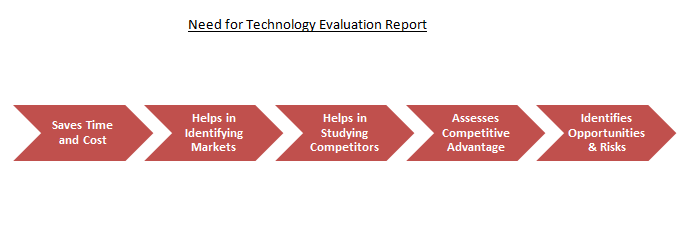Technology Evaluation Report: All You Need to Know
As per the 2019 Global Startup Ecosystem report by Startup Genome, only 1 out of 12 startups succeed. That makes one wonder why the rest of them fail? The primary reason for the failure could be the lack of market need, i.e., manufacturing products that are not in demand. Funding issues, incompetent teams, and getting outcompeted are some other major reasons for the failure of entrepreneurial ventures. In order to avoid going under, companies often look for fail-safe ways, and a technology evaluation report (TER) can help them do just that.
Read this article to know everything about TER and how it can help you in making the most out of your innovative business idea.
Table of Contents
What is a Technology Evaluation Report (TER)?
Before we discuss about TER, let us first understand technology evaluation. Technology evaluation is defined as a set of methods, principles, and tools/techniques for effectively evaluating the potential value of a technology, as well as its contribution to a company, a region, or an industrial sector.
A technology evaluation report (TER) presents information to inventors, patent attorneys, small and medium-sized enterprises (SMEs), or anyone with an idea for assessing the value and impact of a technology in a particular company, region, or sector.
Why Do You Need a Technology Evaluation Report?

- Saves Time and Cost – Performing a technology evaluation study beforehand helps you to see the valuation of a technology and discard a frivolous idea early on. Besides discarding an idea, one can also pivot an idea, i.e., in case an idea requires any improvement, the TER can help you in identifying that area of improvement, thereby helping you pivot on time to save cost and to identify alternative solutions.
- Helps in Identifying Markets – A TER can help you to identify the correct market as well as the right consumers/buyers for a technology. It can also help in identifying specific demographics such as age groups and profession for your product/technology.
- Helps in Studying Competitors – A TER can help you in identifying and studying your competitors so that you can learn from their strategies. These reports also provide information about the products and product features that are being implemented by your competitors. Thus, you can improve upon the features or create something unique based on this knowledge.
- Assesses Competitive Advantage – Once you have a list of competitors and their products, you can assess the advantages of your technology over your competitor. This includes but is not limited to evaluating how your technology is better suited for the customers and what additional benefits your technology provides over the competitors’ technology.
- Identifies Opportunities & Risks – Using a TER, you can identify the application areas of a technology that you might have missed, i.e., secondary application areas of the technology. Besides, you can also identify potential IP or technical risks.
Main Components of a Technology Evaluation Report
- Executive Summary – The executive summary gives a glimpse of the information that is provided in a TER. Essentially, this section provides information about the background of an invention, market competition, intellectual property (IP) competition, and final evaluation of the technology.
- Technology Description – In the technology description section, we first cover the background/broader domain of a technology. For instance, in case of binder jetting process, additive manufacturing is the background/broad domain. Therefore, we provide information about additive manufacturing, followed by a detailed analysis of the technology under observation. While preparing a detailed analysis, the researcher may contact the inventor of the technology to better understand his/her point of view on the technology to create a detailed report.
- Potential Benefits – In this section, we provide the unique selling points (USPs) or advantages of the technology. For instance, if the technology under evaluation is additive manufacturing, then we provide all the advantages of the additive manufacturing process over the conventional manufacturing process. Besides, we also provide advantages of the binder jetting process.
- Potential Markets & Market Interest – This section of the TER covers both narrow and broad market research based on the domain. For instance, in case of binder jetting process, a broad market research is conducted for the domain of the technology, i.e., additive manufacturing process. While a narrow market research is carried out for the binder jetting process.
Apart from market research, this section also covers exemplary geography mapping analysis which helps in identifying the geographical area from where innovation in the domain originates, i.e., the area with the maximum number of patent filings, patent grants, etc. In case of binder jetting process, the main technological innovation comes from the US, followed by China and the European region.
The potential markets & market interest section also helps a business in identifying companies that are working on a particular technology, companies that are using similar technologies, or companies that exist in the domain as well as the products they are using currently.
- Key Opportunities/Application Areas – The key opportunities/application areas section of a TER covers the applications areas of the technology under evaluation. For example, the binder jetting process can be used in tools & mold making, energy, electronics, aerospace & defense, etc.
- Risks & Barriers – This is the second last section of a TER and includes two types of risks/barriers. The first barrier is existing intellectual property (IP). For instance, if a business wants to launch a new technology or use or commercialize a technology, then they need to check what kind of IP already exists in the domain that might act as a barrier to their entry into the market. The second barrier can be any technical challenge. Businesses can use TERs to identify all the technical challenges that they need to overcome.
- Recommendations & Next Steps – Based on the information provided in theTER, a researcher gives a final recommendation. This recommendation might include information about licensing opportunities and a strategy on how to proceed with a product launch. The data provided in the TER can also be used by inventors or startup founders to create an investment pitch book.
Conclusion
Companies must carry out early technology evaluation studies because recommendations from such studies which are included in technology evaluation reports (TERs) can help them in planning their business decisions. In case you are looking for a detailed TER, you can reach out to companies such as ours. Sagacious IP’s Technology Evaluation Report (TER) service serves as a guide for assessing a proposed idea – technology for profitability as well as competitiveness. It enables you to determine the strengths, weaknesses, threats, and opportunities while also steering you further for the next steps. Click here to know more about this service and click here for the webinar on the topic.
-Yogesh Soam (Engineering Searching) and the Editorial Team
Having Queries? Contact Us Now!
"*" indicates required fields




